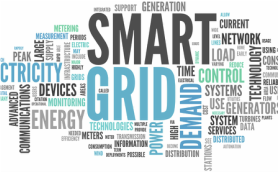
Smart grid, or grid modernization, generally refers to classes of technology, using computer-based remote control and automation. These systems are made possible by two-way communication technology and computer processing that has been used for decades in other industries. They are beginning to be used on electricity networks, from the power plants and wind farms all the way to the consumers of electricity in homes and businesses. They offer many benefits to utilities and consumers ensuring reliability of the grid, maintaining affordability for customers, accommodating renewable and traditional energy sources, potentially reducing the carbon footprint, and integrating future advancements and efficiencies onto the grid. [1]
In 2009, the Department of Energy released $4.5 billion for grid modernization projects through the American Recovery and Reinvestment Act of 2009 (Recovery Act) provided DOE with $4.5 billion to modernize the electric power grid. Since then, over $9 billion has been invested in grid modernization activities. IAMU was fortunate to be one of the 99 recipients through the Smart Grid Investment Grant, charged with modernizing the electric grid, strengthening cybersecurity, improving interoperability, and providing DOE with an unprecedented level of data on smart grid operations and benefits. As many of these projects are coming to a close, a number of resources have been released to help other utilities and industry partners share in the lessons learned and best practices developed along the way, including cost, benefit and performance data, as utilities and regulators work to determine the value of technology and appropriate investment strategies.
At the end of October, DOE published a report on the state of the Smart Grid, and IAMU was privileged to participate in the Smart Grid Experience Summit, sponsored by the Department of Energy and the Electric Power Research Institute. Smart Grid Investment Grant recipients and Smart Grid Demonstration Project participants from around the country gathered share some of their lessons learned and plans for the future. Projects ranged from Advanced Meter Infrastructure (AMI) installations, demand response programs using switches and programmable thermostats, energy storage using batteries, distribution automation, Volt/VAR control, to customer web portals, and various time of use or critical peak pricing plans. Utilities, in general found that AMI, provided opportunities for operational efficiencies. Central Maine Power Company has reduced its meter operations costs by more than 80%. Pricing programs were another area, where utilities had success. Sacramento Municipal Utility District, which piloted several pricing schemes, is shifting all customers to a default time-of-use rate by 2018 based on their pilot program. Baltimore Gas and Electric and Kansas City Power and Light, among others, found that their demand response programs, highly successful in 2013, were impacted by the relatively cool summer in 2014. All utilities commented that their smart grid projects provided new opportunities and challenges for how they communicate with their customers, and how they do business.
The smart grid is changing the way utilities operate, with their customers and with their business operations. The GridWise Alliance published a report in December 2014, outlining the technological and business processes that must adapt to the future grid of 2030. Visions of this future grid include self-learning systems, increased coordination between transmission- level balancing areas, as well as more granular balancing capabilities at the distribution level, balancing capabilities utilizing both supply-side and load-side options, security and privacy concerns, as well as, plug-and-play capabilities. As you plan for your utility in 2015, for your future in 2030, and begin to integrate smart grid technologies into your systems, these resources and lessons learned from utilities around the country may be extremely useful.
[1] “The Smart Grid: an Introduction. Prepared for the US DOE by Litos Strategic Communication. Contract No. DE-AC-26-04NT41817. 2009.

 RSS Feed
RSS Feed
